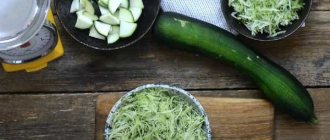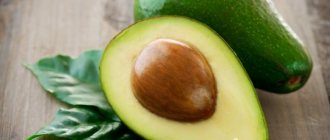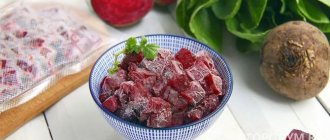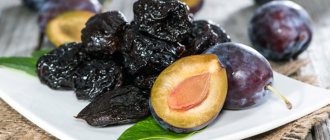In summer, zucchini (previously spelled “zucchini”) are rightfully considered an indispensable vegetable in the diet of both adults and children. Therefore, it is not surprising that many people think about how to store zucchini. In this article we will tell you what methods exist for storing this unique summer vegetable.
To enjoy the taste of fresh zucchini all year round, you need to know how to store them correctly (up to 6-7 months)
Is it possible to store fresh zucchini?
Zucchini is of great interest as a dietary and baby food product. They are perfectly absorbed by the body, do not overload the stomach, and are indicated for people with digestive problems.
Plus, fresh zucchini is very easy to prepare. They are baked, fried, stuffed, and added to soups and salads. Canned vegetables serve as a side dish for dishes in the winter.
To date, breeders have developed 174 varieties of zucchini. The fruits differ in shape, color and taste.
Another characteristic is the fruiting period. Zucchini can be:
- Early ripening. These include the bulk of varieties and hybrids.
- Mid-early. These are Arlica, Aliya, Adrielle, Betsy, Pinocchio, Goodwin, Golda, Donya perfecta, European, Marigold, Excellent Student of Nevira, Sabina.
- Mid-season. These are Caruso, Nice, Spaghetti Raviolo, Spaghetti Femeli, Miracle Orange.
In 2022, a variety recommended by breeders for freezing, Pogrebok, was added to the register.
There are no hybrids or varieties of zucchini for long-term storage on this list. You can store zucchini at home for fresh consumption, but not for long and in small volumes. For the winter, it is better to freeze, dry or preserve them.
- Unripe, juicy fruits with thin skin and small seeds are collected throughout the summer season. They are ideal for preparing rolls and semi-finished products.
- Ripe vegetables are often collected and stored for livestock feed. For culinary use, they have too hard skin, fibrous tasteless pulp and an unpleasant aftertaste.
We answer the question: why does the skin of zucchini turn yellow during storage?
Yellowing of the skin is normal. It indicates the ripening of the vegetable. What’s worse is that the peel becomes thick and tough, and the flesh becomes loose. The taste of the product does not change for the better. Therefore, try not to store fresh vegetables with a reserve; it is better to use other methods.
Basic Rules
Every year, the owners of their own plots are faced with the question of storing the harvest, especially if they do not have an equipped cellar at their disposal and plan to keep all supplies in the apartment (how to store zucchini in the cellar?). After all the vegetables have been sorted into those that will be eaten first and those that will last for several months, you need to decide on a storage method. Let's figure out how to keep zucchini fresh for the winter at home and where it is best to store them.
Rules for harvesting vegetables
To prepare zucchini for the winter, you first need to properly harvest them. This will determine how long they will stay in storage.
Collection time for each region is individual. The main thing is to collect the fruits before they fall under the first autumn frosts. But there’s no need to rush into planting – haste will reduce the time you can use zucchini in winter.
To obtain young fruits, zucchini is cut every 2-3 days so as not to interfere with the ripening of the rest. To store them for winter storage, on the contrary, they wait until they are completely ripe, and the new ovaries are torn off.
Harvest in dry weather when nighttime temperatures approach freezing. To keep zucchini fresh in winter, separate them from the vine, leaving a stalk 5 cm long. Use a sharp knife to make a clean and even cut.
Tip of the day
Do not twist the zucchini. An uneven, torn surface of the stalk causes the formation of rot and premature spoilage of the product.
Damaged, diseased and deformed fruits are not suitable for storage. Set them aside immediately and recycle them.
Dry the zucchini selected for storage thoroughly. To do this, leave the fruits under a canopy for 1-2 days. During this time, the cut on the stalk will dry out and become hard, and the juice will no longer be released.
Tip of the day
Do not wash vegetables before storing. Just carefully remove any dried soil from the fruit, being careful not to damage the skin.
Fruit selection
Before storing, you need to select the right fruits. If you have your own summer cottage, you should choose the right type of zucchini for planting .
Experienced summer residents advise storing zucchini with white skin (for example, fruits of the following varieties: “Belogor”, “Beloplodnye”, “Gribovsky 37” - the oldest and still one of the best, “Anchor”, “Sosnovsky”, “Rolik” ). By winter, their skin becomes thick and impenetrable (this happens with all pumpkins), they store well, no worse than zucchini.
At the same time, it is recommended to store not classic zucchini, but zucchini - it is widely believed that they retain their original qualities much better due to the structure of the fruit.
For long-term storage, it is better to choose zucchini or white-fruited squash.
If possible, it is better to store the fruits immediately after picking them from the bush. First of all, put overripe specimens aside - they will not last long. You should choose medium-sized, ripe vegetables . If you buy zucchini at the market and cannot determine how ripe they are, do a little test: try piercing the skin with your fingernail. If this is very difficult or impossible to do, then the fruit is suitable for storage.
For long-term storage, choose fruits that are fully ripe, but not overripe.
Pay attention to the condition of the fruit's surface. You can keep zucchini fresh for a long time only if there are no damages or flaws on them. The slightest scratch on the skin will lead to rot, which will quickly spread to the entire batch of vegetables. zucchini with stalks for storage .
Before storing vegetables, it is recommended to carefully clean them from the soil and dry them a little in the sun (do not wash them). After this manipulation, the peel will become harder, which will significantly extend the shelf life of the vegetable.
Before storing zucchini, you cannot wash it; just wipe it with a dry cloth.
Storage conditions for zucchini
The keeping quality of zucchini depends on many factors. Under optimal conditions, the product can remain fresh for 4-5 months. This is only possible in a well-equipped and adapted place. But even here, by the end of the period, the vegetable will lose most of its nutritional and taste properties.
During storage, zucchini ripen and may even begin to sprout, so it is better to consume or process all supplies within 2-3 weeks after collection
Under normal room conditions, unripe vegetables last 1-2 weeks, ripe ones - up to 1 month. If you keep them in the refrigerator, you can add another 1-2 weeks.
The following conditions are considered ideal for storing fresh zucchini:
- temperature 5-10 ⁰С;
- humidity 90-95%;
- lack of light;
- good ventilation of the room, but without drafts.
If you have a private home, the best place for storage would be a cellar or basement. There is the most suitable microclimate for vegetables, including fresh zucchini.
You can keep zucchini in a garage, shed or on the veranda, but under one condition. With the onset of severe frosts, the product will have to be moved indoors or the room heated. Even slightly frozen fruits quickly deteriorate and disappear.
Fewer options for where to store zucchini remain in the apartment. Close to ideal conditions can be found on a balcony or loggia, if they are well insulated.
You can also keep the fruits in the room in front of the balcony door, where the air temperature is the lowest. In a pinch, any place under a table or bed will do, but at room temperature the product will stay fresh the least.
We answer the question: is it possible to store zucchini along with potatoes?
There are no special contraindications for this. These vegetables need the same temperature and humidity. Potatoes produce almost no ethylene, which could speed up the ripening of zucchini. If you don’t mind that the latter may become saturated with the potato smell, store them.
Timing and technology of harvesting
No matter what time you plant the plant on your site, you need to harvest the fruit before the first frost, since frozen specimens are no longer suitable for further storage. You can identify zucchini suitable for harvesting by its thick skin (a dull sound is heard when you tap on the surface) and the absence of growth defects or mechanical damage. In addition, high-quality specimens should have well-marked lines characteristic of a particular variety. Even if the harvested fruits are not fully ripe, they will be able to reach the desired state indoors.
As for harvesting technology, it is always worth remembering the correct cutting of zucchini: on each specimen there should be a small tail 4–5 cm long, with an even cut line and no separation into several parts (this happens if they tried to unscrew the fruit from the stalk, and not cut with a sharp knife). Only by correctly separating the fruit from the bush can you protect the inner pulp of the plant from the effects of pathogens and control the condition of the harvest during winter storage.
Picked fresh zucchini cannot be washed (this can provoke the onset of rotting processes) - on the contrary, after collecting them from the garden, it is advisable to further dry them in a well-ventilated place and wipe them with a dry, clean cloth.
Did you know? The most tender and delicious vegetables will be fruits no more than 12 days old. Their flesh is so soft and juicy that in addition to baking in the oven or boiling in a pan, they can also be eaten raw, adding to fresh salads.
Fresh storage methods
There are several simple ways to preserve zucchini before processing. They are more suitable for a private home, but they can also be used in an apartment. Choose which one is right for you.
- On racks or wooden pallets. Vegetables are placed in one row, having previously laid straw, hay or thick paper under them. The fruits are placed so that they do not touch each other.
- In boxes with stems up. In order to protect the fruits from contact, cardboard and fabric are placed between them. You can also wrap each copy in paper, which will further protect the vegetables from an accidental drop in temperature.
- In vegetable nets that are hung on hooks in the cellar. As practice shows, this is a reliable way to preserve fresh zucchini in winter.
Check your bookmark regularly for damage. Dispose of rotten or limp specimens immediately.
You can recognize spoilage in time by a rotten stalk
We answer the question: why do zucchini stored fresh taste bitter?
There are many reasons for bitterness. The main one is that this is a normal spoilage process, since this vegetable is not stored for fresh consumption.
You can get rid of the bitter taste by soaking zucchini cut for cooking in a salty solution (2 tablespoons of salt per 1 liter of water) for 30-40 minutes. However, the taste qualities have already been lost, and you need to try very hard to make a culinary yummy out of such a product.
Choose the right variety
Zucchini contains many vitamins: B1, B3, A, C, beneficial acids and microelements. They are even introduced first as complementary foods to infants.
My mother knew that not all varieties of zucchini can be stored for a long time at home. I searched on agricultural websites to find out which varieties can be stored for a long time:
| Variety "Festival" Yellow-green striped zucchini, up to 15 cm in diameter. Storage-resistant variety - can be stored for up to 10 months. Can be fried, stewed, baked, stuffed | |
| Variety "Aeronaut" An early variety with a cylindrical shape. Ready for use 1.5 months after planting. Stores up to four months | |
| Variety "Pear-shaped" An early root crop in the shape of a pear, orange in color. The thick skin allows the zucchini to be stored for a long time: up to six months | |
| Variety "Watermelon" This variety is a hybrid of zucchini and watermelon. Thick skin, tasty pulp. Stored until next harvest | |
| Variety "Yellow-fruited" A small fruit - up to 1 kg, cylindrical in shape, rich yellow in color. Can be stored for three months |
All zucchini are divided into:
- Early ripening (35–40 days).
- Early ripening (40–50 days).
- Mid-season (50–60 days).
If you don’t wait until ripeness and pick small fruits, they won’t last long. The zucchini is ripe if it has a thick skin and makes a characteristic dull sound when tapped.
Unripe zucchini, as in the photo, is not stored for a long time, so wait until it is completely ripe. You can determine the ripeness of a vegetable by its thick peel and dull sound when tapped.
Zucchini in the refrigerator
Those who are looking for a reliable way to store zucchini in the apartment should definitely use the refrigerator. But in a private house this option will not be superfluous. Modern refrigerators have enough space to store food items for the winter. You can use both the main chamber and the freezer.
In the vegetable compartment
Whole zucchini can last 2-3 weeks in the vegetable compartment. The temperature inside the chamber is ideal, but the humidity is excessive.
Want to preserve your vegetables longer? Wrap them in thick paper or put them in a paper bag with a few holes. This way the vegetable will be protected from excess moisture and will be able to breathe.
We answer the question: what is the best way to store peeled and cut zucchini?
If you have any unused peeled vegetables, wrap them in a plastic bag or damp paper towel. Place the cut pieces into a container with a lid. Store in the refrigerator for no longer than 3 days.
In the freezer
Zucchini can be frozen for the winter. Here are recipes for preparing preparations that will always be on hand in the winter:
- unripe fruits well and dry. Cut into circles 0.5-1 cm thick. Place in bags in portions of several pieces and put in the freezer. Small fruits can also be cut into strips along the entire length of the fruit.
- the mature vegetables into cubes. They must first be peeled and the seeds removed. The sizes of the cubes may vary. Focus on the dishes you will prepare. Place the finished cuts in plastic bags or containers. Store in the freezer.
- For caviar, soups or pancakes, grate the zucchini. Use young fruits whole, and pre-prepare large ripe ones as in the previous recipe. Divide the mass into portions. Store in the freezer in bags or containers.
To preserve the taste of the vegetable as much as possible, you can blanch it before freezing.
You can store vegetables in the freezer for a very long time. In the case of zucchini, you can safely expect that they will be on your table until the new harvest.
Tip of the day
Remove frozen vegetables only just before use. Use without defrosting so that the fruits do not lose their integrity. But be prepared that during the cooking process they will turn into puree. However, this will not affect the taste in any way.
Do not freeze the product twice. This will spoil its taste.
Which varieties are suitable for long-term storage?
Not all varieties of zucchini will survive the winter. The main requirements are a thick peel and as uniform pulp as possible. The seeds are small, soft, poorly developed. Several varieties fit the description:
- Golden Cup, Festival - the best choice for long-term storage; after harvesting, if properly stored, vegetables will “live” for 5 months;
- Aeronaut, Pear-shaped, Arlika, Zheltoplodny - varieties with a shelf life of 3-4 months;
- Negritenok, Anchor - zucchini is good for 1-2 months.
Do you store overripe zucchini until winter?
Not really
When choosing zucchini or zucchini for long-term storage, you need to consider more than one variety. The varieties listed above differ not only in appearance, but also in taste. Although all of them are well suited for dietary dishes and baby food.
If you follow the instructions on how to properly store zucchini, then after harvesting they will remain fresh and edible for 5 months. Vegetables tolerate overexposure well at +10° with a humidity of no higher than 86%. The place is dry, well ventilated, dark, impenetrable.
Other storage methods
If the zucchini harvest is large, processing will help preserve it. Young juicy fruits are ideal for canning. More mature vegetables can be dried or dried.
Canning
Every housewife has recipes for making rolls that suit the tastes of the family and do not require much time to prepare. If desired, you can make salted or pickled zucchini. Zucchini jam with the addition of citrus fruits has an excellent taste. Such exoticism makes children very happy.
Many people love and prepare zucchini caviar, combining zucchini with cucumbers, tomatoes, eggplants and other vegetables. Korean-style zucchini and zucchini lecho with bell pepper are also successful. Such rolls not only add variety to the table in winter, but can also serve as a quick snack when you don’t have time to stand at the stove for a long time.
Try making this winter snack using the recipe from the video:
Preservation is very easy. It does not require special conditions. In a private house, a dry cellar, basement or underground is suitable. The apartment has a storage room or a balcony. The workpieces will stand well at room temperature. Their shelf life is 1-2 years.
Recommendations for use
You can eat harvested vegetables in the same way as freshly cut vegetables. If we are talking about young zucchini with delicate and thin skin, then they can be baked, boiled or fried without removing it. For ripe fruits with thick skin, this procedure is required, otherwise the taste of the finished dish will not be so soft. Stale and slightly softened fruits are not as suitable for preservation as freshly picked ones, so you should only make preparations from vegetables that have been in storage for no more than 1–2 weeks.
Did you know? The longest zucchini in the Guinness Book of Records grew in the garden of Englishman Alberto Mercantonia from Hitchino. The length of the miracle vegetable was 1.6 m, which corresponded to the height of the Briton himself.
It is advisable to defrost zucchini from the freezer on the bottom shelf of the refrigerator or simply on the table at room temperature. True, you don’t have to waste time on this to prepare stews or fried dishes.
In general, storing zucchini will not require any excessive effort from you, so no matter what room you allocate for storage, if the temperature conditions are met and the required level of humidity is maintained, you can achieve the maximum shelf life.
How to store zucchini
Zucchini is considered the longest-lived among all zucchini. The fact is that under good conditions they lie literally until a new harvest appears. The most important thing is to choose the appropriate variety. It is recommended to take only dense fruits with a hard crust.
It is necessary to collect the vegetables correctly: only the ripest and fairly dense ones, about 15 centimeters long, are suitable. They are removed from the bush with sharp pruning shears, but the tail is not completely cut off, but left. Then the collected material is cleared of soil and left under the sun for about a day.
You can leave zucchini in the freshness zone of the refrigerator by wrapping it in a paper bag with several holes. They also tolerate freezing well, remaining fresh throughout the year. They are washed, the stalks are removed and cut into a convenient way. Lay out on a cutting board, not allowing them to touch. They put it in the freezer for several hours, and then put it in a container or bag and return it.











